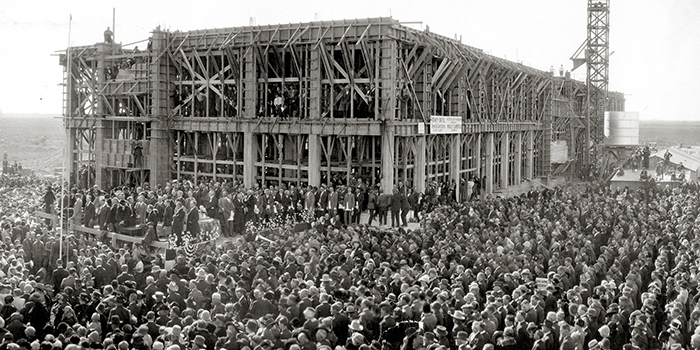A Rocky Road with a Triumphant Ending
The Texas Story Project.

The South Plains of West Texas are filled with wide-open spaces, hardworking people, and opportunity—just as they were when settlers came to the area in the late 1800s. These pioneers realized that this part of Texas was full of possibility for their children and for many generations to come. So in the late 19th century, the settlers began to push for a major public university in their area, since Austin and College Station were many hundreds of miles away. This dream would travel a long and rocky road before it came to fruition.
In 1917, it looked as though Abilene would be the closest location for a major South Plains university. That year, the Texas legislature passed a bill that would create a Texas A&M branch campus there. It turned out, however, that then Governor James Ferguson had falsely reported that the site committee had chosen Abilene. The bill was repealed, and Ferguson was impeached. Setback number one.
In 1921, another bill was passed to create West Texas Agricultural and Mechanical College. But when it made it to new Governor Pat Neff’s desk, he vetoed it due to what he called “hard financial times” in West Texas. This veto caused an uproar among Texans in the Panhandle and South Plains. They were so incensed by the actions in Austin that they formed the Sweetwater Secession Movement in a superficial effort to secede from Texas. Setback number two.
The year 1923 brought a new idea and long-awaited forward momentum. The Texas legislature decided that a new university would serve the citizens and the West Texas region better than a branch campus would. On February 10, Governor Neff signed Senate Bill 103, authored by Senator William H. Bledsoe of Lubbock and Representative Lewis Carpenter of Dallas, creating Texas Technological College (now Texas Tech University).
In the summer of 1923, thirty-seven West Texas towns submitted proposals to the locating committee stating why their communities would be the perfect site for the new college. Since the proposal parameters were very broad, some smaller communities submitted pamphlets only a few pages long, while larger towns sent professionally printed, leather-bound books detailing what they had to offer in terms of transportation, water, population, schools, and demographics. In August, the locating committee selected Lubbock as the site for Texas Tech, largely due to the citizens’ support of the university and commitment to its success. Construction of Texas Tech’s first building began in 1924. On October 1, 1925, the doors were officially opened, and nearly one thousand Texas Tech Matadors were enrolled in one of the university’s four schools: Agriculture, Engineering, Home Economics, and Liberal Arts.
From such humble beginnings, a major educational powerhouse emerged in Texas, spurring growth and new opportunities in the vast West Texas plains.
“Strive for honor evermore. Long live the Matadors!”
Lacey Nobles, a San Angelo native, moved to Lubbock to become a Red Raider ten years ago and is now the reporter for Texas Tech University in Lubbock.
Posted January 08, 2015
Join 3 others and favorite this
TAGGED WITH: Education